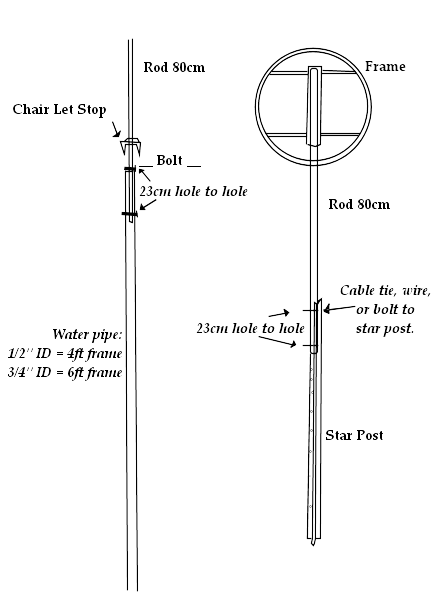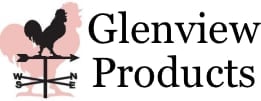Windsock to Frame
Attach windsock to frame using the cable ties supplied, keeping the longitudinal seams of the windsock at the 3 & 9 o’clock positions. The cable ties should be tight enough so that the windsock is restricted form rubbing on the frame rim.
Windsock Frame to Vertical Support
Any suitable support pole or pipe may be used to gain the required windsock height.
If a pipe is being used, insert a bolt or a pin, through the upper hole in the support rod, then insert the rod into the pipe. A rubber cap, such as a chair leg end piece, may be used to cover the join.

Note that the 23cm space between the holes of the frame support rod, will match up with the hole spacing of most BHP metal star posts and may be directly attached using wire, bolts or cable ties.
This method is well suited to a 4 foot windsock; and using two star posts joined, will well suit a 6 foot windsock. (The extra height needed, due to extra length.)
Tape over any sharp parts that are within the sweep of the windsock, or cut a hole in a plastic spray can lid, a small tin can, or cut the base out of a plastic bottle, then sleeve onto the support rod in order to cover any rough projections that could snag the windsock at this joint.
For a more permanent windsock installation, the star post section may be covered with any suitable 50mm PVC vent pipe so that there are no external sharp parts that could cause windsock damage. This pipe is readily available at around $6/m
It is recommended to snip the cable ties and rotate the windsock, top to bottom (180°) on a yearly basis.
Standard cable ties may be used, the black ties tend to be more ultraviolet resistant than the clear ones, and as a result the black ones should last longer.
It is important that the windsock pole and frame is exactly vertical, or the windsock will constantly swing to one side.
The 4 & 6 foot windsocks are available in ripstop, they are chemical & UV resistant, and of a lightweight sailcloth material in white, yellow, pink or orange.
White has the least problem with fade, Yellow can normally be see the greatest distance, and tends to attract attention more than the white. Pink is used on grassland and forest areas, where white or yellow blossoms are possible, and orange is used in snow areas only.
